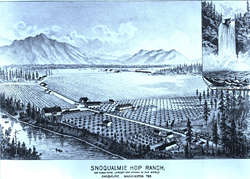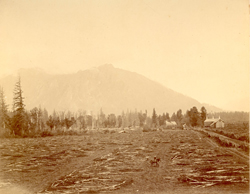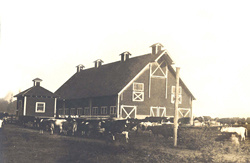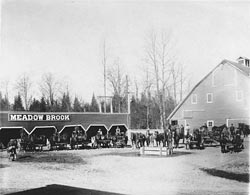The land that is now Meadowbrook Farm has been a focal site of human activity for thousands of years. In Snoqualmie tribal oral tradition, the origin of both the tribe and the world involved this prairie above the falls, between Mt. Si and Rattlesnake Ridge.
During the last ice age, 18,000 years ago, the advance and retreat of massive glaciers sculpted the grooved volcanic bedrock of the Snoqualmie Valley floor. The valley was filled and flattened when a huge foothills lake broke through its glacial dam, flooding the land with stones, pebbles and sand. People-the ancestors of today's Snoqualmie Tribe – were living in the valley shortly thereafter, at least 9,000 years ago.
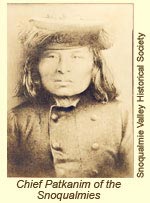 The Snoqualmies lived on this prairie, hunting elk, deer and small game, and drying and smoking salmon caught
below the falls. Cedar provided split planks for longhouses, wood for canoes, tools, and accessories, bark for clothing
and mats, and roots for baskets and weaving. Camas, lilies, bracken fern, wild carrot and a succession
of berries were gathered on the open prairie valley floor. Every few years, the prairie was carefully burned,
to keep the grassland open for food crops and hunting. Travel between the saltwater coast, and across the pass
allowed trade and cultural exchange with other tribes.
The Snoqualmies lived on this prairie, hunting elk, deer and small game, and drying and smoking salmon caught
below the falls. Cedar provided split planks for longhouses, wood for canoes, tools, and accessories, bark for clothing
and mats, and roots for baskets and weaving. Camas, lilies, bracken fern, wild carrot and a succession
of berries were gathered on the open prairie valley floor. Every few years, the prairie was carefully burned,
to keep the grassland open for food crops and hunting. Travel between the saltwater coast, and across the pass
allowed trade and cultural exchange with other tribes.
As explorers, fur traders, and later settlers came to the Puget Sound region in the 1800's, they initially traveled by sea, and ventured inland on the rivers. In about 1850, Virginian Samuel Hancock and four Snoqualmie guides canoed from Puget Sound to the base of Snoqualmie Falls, then carried their canoe and gear up the steep trail to the top of the falls. Relaunching the canoe, they traveled another two miles upriver, a place where Hancock was told in Chinook, "highas kloshe illahees" ("here the land is good".) Climbing up the riverbank, he saw, (and described in the first written account,) the vast open prairie as it had been carefully maintained for many centuries, with the river winding through it, and traversed by a well-worn trail that crossed the mountains.
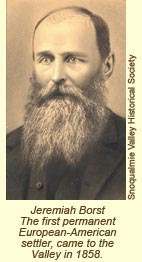 As settlers increased in coastal Washington Territory, a series of hasty treaties with the Native American residents
were put into effect in 1854-1855. Although no white settlers had yet entered the Snoqualmie Valley, Snoqualmie Chief
Patkanim wished to maintain good relations with the whites, whose numbers he saw as endless. The Snoqualmies and their
lands were included in the treaty of 1855. Some tribes reacted violently, raiding farms and attacking the tiny village
of Seattle. A series of small log blockhouses were built by militia units to defend against feared attacks from across the
Cascades. The largest of these was Fort Alden, on the edge of the prairie above the falls. When no attacks materialized,
the forts were abandoned in 1856.
As settlers increased in coastal Washington Territory, a series of hasty treaties with the Native American residents
were put into effect in 1854-1855. Although no white settlers had yet entered the Snoqualmie Valley, Snoqualmie Chief
Patkanim wished to maintain good relations with the whites, whose numbers he saw as endless. The Snoqualmies and their
lands were included in the treaty of 1855. Some tribes reacted violently, raiding farms and attacking the tiny village
of Seattle. A series of small log blockhouses were built by militia units to defend against feared attacks from across the
Cascades. The largest of these was Fort Alden, on the edge of the prairie above the falls. When no attacks materialized,
the forts were abandoned in 1856.
Hearing of "good land" in the area, Jeremiah Borst, a young adventurer and trader, hiked up the Cedar River and into the valley in 1858. Finding what he thought was a vast natural prairie ideal for farming, he set up housekeeping (initially in the abandoned Fort Alden blockhouse), traveled back and forth to Seattle for supplies, fruit trees and livestock, and married a Snoqualmie woman. Borst's homestead included much of what is now Meadowbrook Farm. Later, as other settlers arrived, and as travelers crossed the pass, they found the Borsts ready to host them, supply them, or help them find land. Yearly trading trips took produce, fruit, hams and smoked meat to Seattle by canoe, and Borst steadily bought more land.
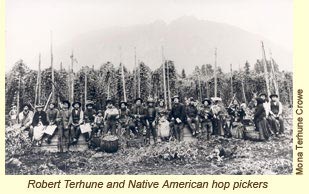 In 1882, Borst sold much of his property to a new company, the Hop Growers Association, and moved his family to nearby
Tollgate Farm. Taking advantage of European crop failures, hops became a lucrative crop, involving eventually some 900 acres
("the world's largest hop farm"), with hop kilns for drying, camps and housing for workers, barns, and a three story
summer hotel. Work on the hop ranch involved many people, including nearly a thousand seasonal pickers-many Native
Americans from as far away as eastern Washington and Alaska. When falling prices and parasitic aphids ended the "hops craze"
the land was sold and converted to growing hay, potatoes, corn and beans.
In 1882, Borst sold much of his property to a new company, the Hop Growers Association, and moved his family to nearby
Tollgate Farm. Taking advantage of European crop failures, hops became a lucrative crop, involving eventually some 900 acres
("the world's largest hop farm"), with hop kilns for drying, camps and housing for workers, barns, and a three story
summer hotel. Work on the hop ranch involved many people, including nearly a thousand seasonal pickers-many Native
Americans from as far away as eastern Washington and Alaska. When falling prices and parasitic aphids ended the "hops craze"
the land was sold and converted to growing hay, potatoes, corn and beans.
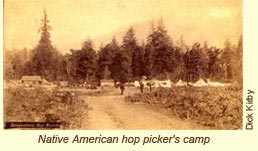 In 1904, Seattle dairy farmer A.W. Pratt purchased what was then known as Meadowbrook Farm, and hired Angus Moffat as
manger. Moffat built fences with the cedar hop poles, constructed dairy barns, built a creamery, and supervised dairy
herds as well as crops over the next 39 years. The Meadowbrook Hotel was converted to worker housing, and the neighborhood
of Meadowbrook (now part of Snoqualmie) was platted at the west end of the farm.
In 1904, Seattle dairy farmer A.W. Pratt purchased what was then known as Meadowbrook Farm, and hired Angus Moffat as
manger. Moffat built fences with the cedar hop poles, constructed dairy barns, built a creamery, and supervised dairy
herds as well as crops over the next 39 years. The Meadowbrook Hotel was converted to worker housing, and the neighborhood
of Meadowbrook (now part of Snoqualmie) was platted at the west end of the farm.
In the 1960's, the farm was sold to the Snoqualmie Valley Land Company, a group of local investors. As they actively marketed the property over the next 30 years, parcels were sold for schools and businesses, while leaving the core of the farm intact, and producing crops. Following several development proposals, a vision emerged of keeping the remaining farm as public open space, complementing recent public purchases at Three Forks Natural Area, the Mt Si Conservation Area, and Rattlesnake Ridge, in the 100 mile Mountains to Sound Greenway Corridor.
Meadowbrook Farm was purchased into public ownership by the Cities of Snoqualmie and North Bend in 1996. Managed by the non-profit Meadowbrook Farm Preservation Association, this 460 acre piece of the prairie above the falls is once again – miraculously – public open space!


